engine Alfa Romeo 4C 2015 Owner handbook (in English)
[x] Cancel search | Manufacturer: ALFA ROMEO, Model Year: 2015, Model line: 4C, Model: Alfa Romeo 4C 2015Pages: 199, PDF Size: 7.67 MB
Page 154 of 199
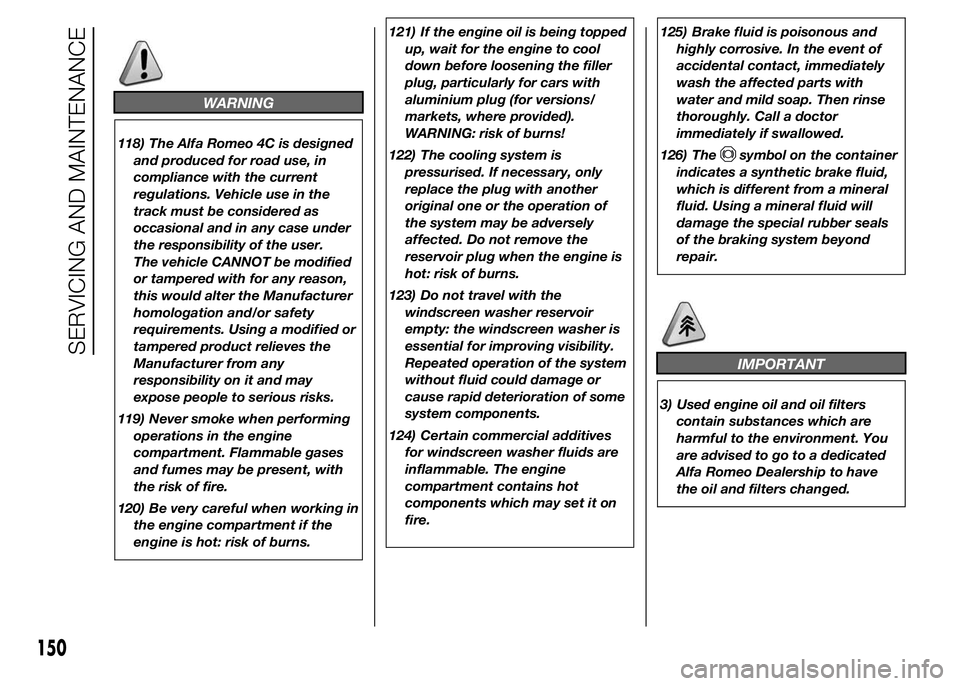
WARNING
118) The Alfa Romeo 4C is designed
and produced for road use, in
compliance with the current
regulations. Vehicle use in the
track must be considered as
occasional and in any case under
the responsibility of the user.
The vehicle CANNOT be modified
or tampered with for any reason,
this would alter the Manufacturer
homologation and/or safety
requirements. Using a modified or
tampered product relieves the
Manufacturer from any
responsibility on it and may
expose people to serious risks.
119) Never smoke when performing
operations in the engine
compartment. Flammable gases
and fumes may be present, with
the risk of fire.
120) Be very careful when working in
the engine compartment if the
engine is hot: risk of burns.121) If the engine oil is being topped
up, wait for the engine to cool
down before loosening the filler
plug, particularly for cars with
aluminium plug (for versions/
markets, where provided).
WARNING: risk of burns!
122) The cooling system is
pressurised. If necessary, only
replace the plug with another
original one or the operation of
the system may be adversely
affected. Do not remove the
reservoir plug when the engine is
hot: risk of burns.
123) Do not travel with the
windscreen washer reservoir
empty: the windscreen washer is
essential for improving visibility.
Repeated operation of the system
without fluid could damage or
cause rapid deterioration of some
system components.
124) Certain commercial additives
for windscreen washer fluids are
inflammable. The engine
compartment contains hot
components which may set it on
fire.125) Brake fluid is poisonous and
highly corrosive. In the event of
accidental contact, immediately
wash the affected parts with
water and mild soap. Then rinse
thoroughly. Call a doctor
immediately if swallowed.
126) Thesymbol on the container
indicates a synthetic brake fluid,
which is different from a mineral
fluid. Using a mineral fluid will
damage the special rubber seals
of the braking system beyond
repair.
IMPORTANT
3) Used engine oil and oil filters
contain substances which are
harmful to the environment. You
are advised to go to a dedicated
Alfa Romeo Dealership to have
the oil and filters changed.
150
SERVICING AND MAINTENANCE
Page 155 of 199
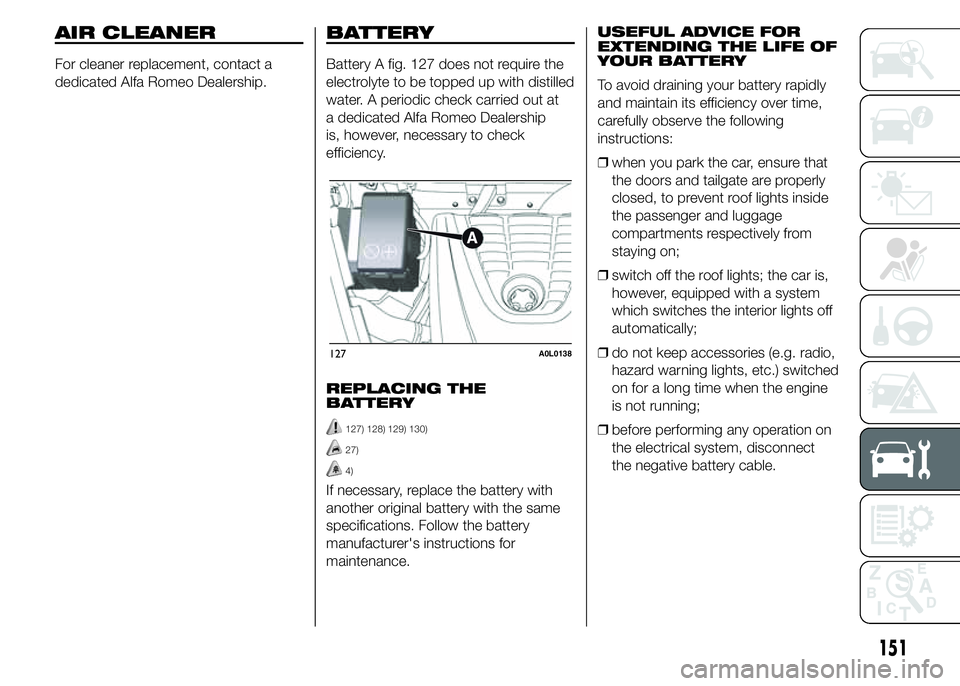
AIR CLEANER
For cleaner replacement, contact a
dedicated Alfa Romeo Dealership.
BATTERY
Battery A fig. 127 does not require the
electrolyte to be topped up with distilled
water. A periodic check carried out at
a dedicated Alfa Romeo Dealership
is, however, necessary to check
efficiency.
REPLACING THE
BATTERY
127) 128) 129) 130)
27)
4)
If necessary, replace the battery with
another original battery with the same
specifications. Follow the battery
manufacturer's instructions for
maintenance.USEFUL ADVICE FOR
EXTENDING THE LIFE OF
YOUR BATTERY
To avoid draining your battery rapidly
and maintain its efficiency over time,
carefully observe the following
instructions:
❒when you park the car, ensure that
the doors and tailgate are properly
closed, to prevent roof lights inside
the passenger and luggage
compartments respectively from
staying on;
❒switch off the roof lights; the car is,
however, equipped with a system
which switches the interior lights off
automatically;
❒do not keep accessories (e.g. radio,
hazard warning lights, etc.) switched
on for a long time when the engine
is not running;
❒before performing any operation on
the electrical system, disconnect
the negative battery cable.
127A0L0138
151
Page 160 of 199
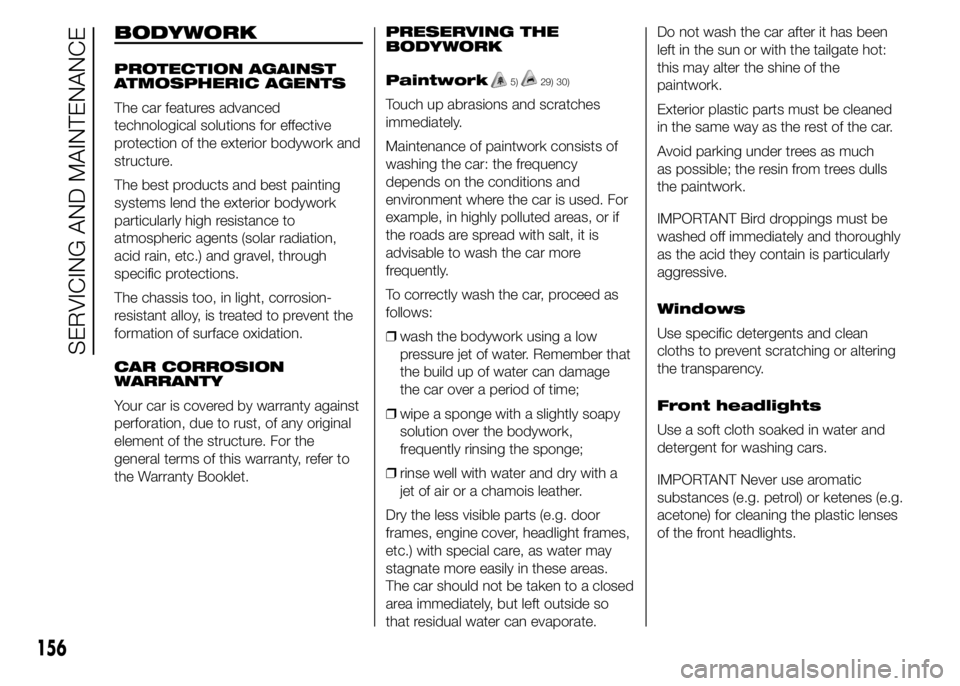
BODYWORK
PROTECTION AGAINST
ATMOSPHERIC AGENTS
The car features advanced
technological solutions for effective
protection of the exterior bodywork and
structure.
The best products and best painting
systems lend the exterior bodywork
particularly high resistance to
atmospheric agents (solar radiation,
acid rain, etc.) and gravel, through
specific protections.
The chassis too, in light, corrosion-
resistant alloy, is treated to prevent the
formation of surface oxidation.
CAR CORROSION
WARRANTY
Your car is covered by warranty against
perforation, due to rust, of any original
element of the structure. For the
general terms of this warranty, refer to
the Warranty Booklet.PRESERVING THE
BODYWORK
Paintwork5)29) 30)
Touch up abrasions and scratches
immediately.
Maintenance of paintwork consists of
washing the car: the frequency
depends on the conditions and
environment where the car is used. For
example, in highly polluted areas, or if
the roads are spread with salt, it is
advisable to wash the car more
frequently.
To correctly wash the car, proceed as
follows:
❒wash the bodywork using a low
pressure jet of water. Remember that
the build up of water can damage
the car over a period of time;
❒wipe a sponge with a slightly soapy
solution over the bodywork,
frequently rinsing the sponge;
❒rinse well with water and dry with a
jet of air or a chamois leather.
Dry the less visible parts (e.g. door
frames, engine cover, headlight frames,
etc.) with special care, as water may
stagnate more easily in these areas.
The car should not be taken to a closed
area immediately, but left outside so
that residual water can evaporate.Do not wash the car after it has been
left in the sun or with the tailgate hot:
this may alter the shine of the
paintwork.
Exterior plastic parts must be cleaned
in the same way as the rest of the car.
Avoid parking under trees as much
as possible; the resin from trees dulls
the paintwork.
IMPORTANT Bird droppings must be
washed off immediately and thoroughly
as the acid they contain is particularly
aggressive.
Windows
Use specific detergents and clean
cloths to prevent scratching or altering
the transparency.
Front headlights
Use a soft cloth soaked in water and
detergent for washing cars.
IMPORTANT Never use aromatic
substances (e.g. petrol) or ketenes (e.g.
acetone) for cleaning the plastic lenses
of the front headlights.
156
SERVICING AND MAINTENANCE
Page 161 of 199
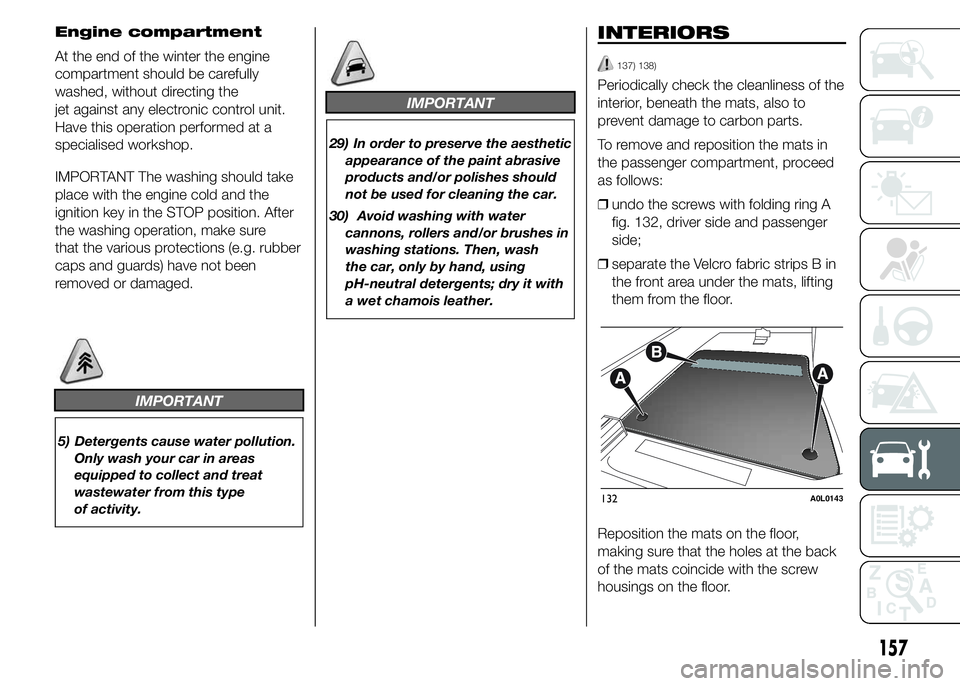
Engine compartment
At the end of the winter the engine
compartment should be carefully
washed, without directing the
jet against any electronic control unit.
Have this operation performed at a
specialised workshop.
IMPORTANT The washing should take
place with the engine cold and the
ignition key in the STOP position. After
the washing operation, make sure
that the various protections (e.g. rubber
caps and guards) have not been
removed or damaged.
IMPORTANT
5) Detergents cause water pollution.
Only wash your car in areas
equipped to collect and treat
wastewater from this type
of activity.
IMPORTANT
29) In order to preserve the aesthetic
appearance of the paint abrasive
products and/or polishes should
not be used for cleaning the car.
30) Avoid washing with water
cannons, rollers and/or brushes in
washing stations. Then, wash
the car, only by hand, using
pH-neutral detergents; dry it with
a wet chamois leather.
INTERIORS
137) 138)
Periodically check the cleanliness of the
interior, beneath the mats, also to
prevent damage to carbon parts.
To remove and reposition the mats in
the passenger compartment, proceed
as follows:
❒undo the screws with folding ring A
fig. 132, driver side and passenger
side;
❒separate the Velcro fabric strips B in
the front area under the mats, lifting
them from the floor.
Reposition the mats on the floor,
making sure that the holes at the back
of the mats coincide with the screw
housings on the floor.
132A0L0143
157
Page 165 of 199
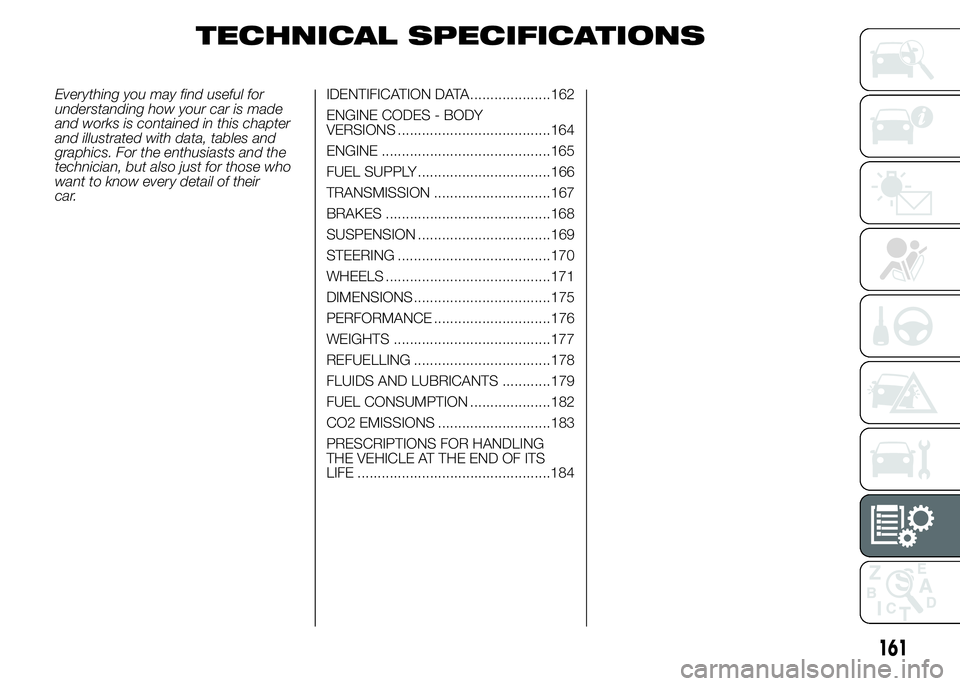
TECHNICAL SPECIFICATIONS
Everything you may find useful for
understanding how your car is made
and works is contained in this chapter
and illustrated with data, tables and
graphics. For the enthusiasts and the
technician, but also just for those who
want to know every detail of their
car.IDENTIFICATION DATA....................162
ENGINE CODES - BODY
VERSIONS ......................................164
ENGINE ..........................................165
FUEL SUPPLY .................................166
TRANSMISSION .............................167
BRAKES .........................................168
SUSPENSION .................................169
STEERING ......................................170
WHEELS .........................................171
DIMENSIONS ..................................175
PERFORMANCE .............................176
WEIGHTS .......................................177
REFUELLING ..................................178
FLUIDS AND LUBRICANTS ............179
FUEL CONSUMPTION ....................182
CO2 EMISSIONS ............................183
PRESCRIPTIONS FOR HANDLING
THE VEHICLE AT THE END OF ITS
LIFE ................................................184
161
Page 166 of 199
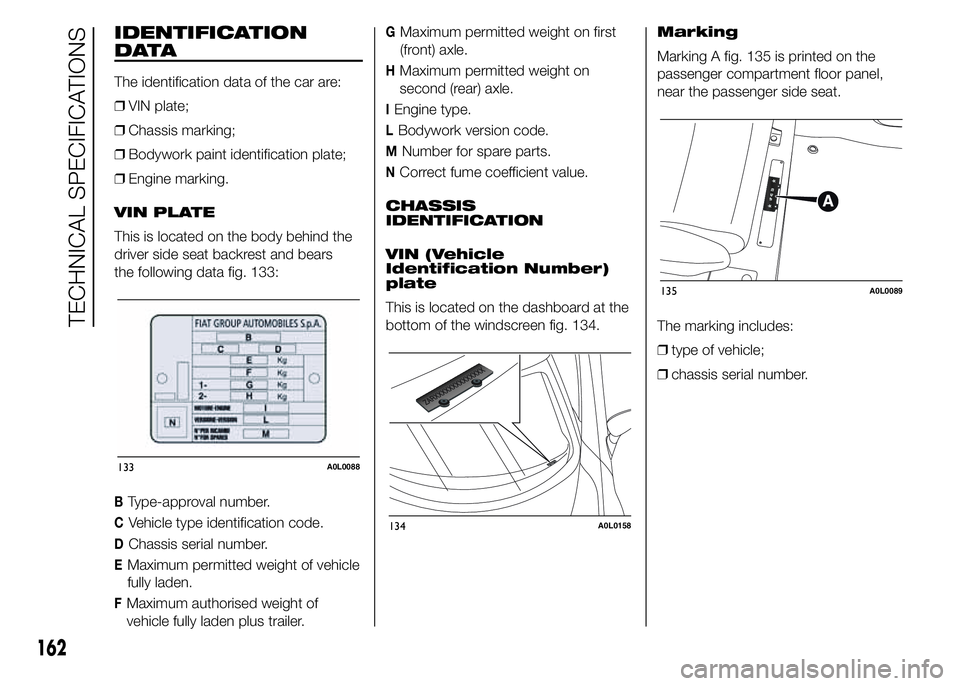
IDENTIFICATION
DATA
The identification data of the car are:
❒VIN plate;
❒Chassis marking;
❒Bodywork paint identification plate;
❒Engine marking.
VIN PLATE
This is located on the body behind the
driver side seat backrest and bears
the following data fig. 133:
BType-approval number.
CVehicle type identification code.
DChassis serial number.
EMaximum permitted weight of vehicle
fully laden.
FMaximum authorised weight of
vehicle fully laden plus trailer.
GMaximum permitted weight on first
(front) axle.
HMaximum permitted weight on
second (rear) axle.
IEngine type.
LBodywork version code.
MNumber for spare parts.
NCorrect fume coefficient value.
CHASSIS
IDENTIFICATION
VIN (Vehicle
Identification Number)
plate
This is located on the dashboard at the
bottom of the windscreen fig. 134.Marking
Marking A fig. 135 is printed on the
passenger compartment floor panel,
near the passenger side seat.
The marking includes:
❒type of vehicle;
❒chassis serial number.
133A0L0088
134A0L0158
135A0L0089
162
TECHNICAL SPECIFICATIONS
Page 167 of 199
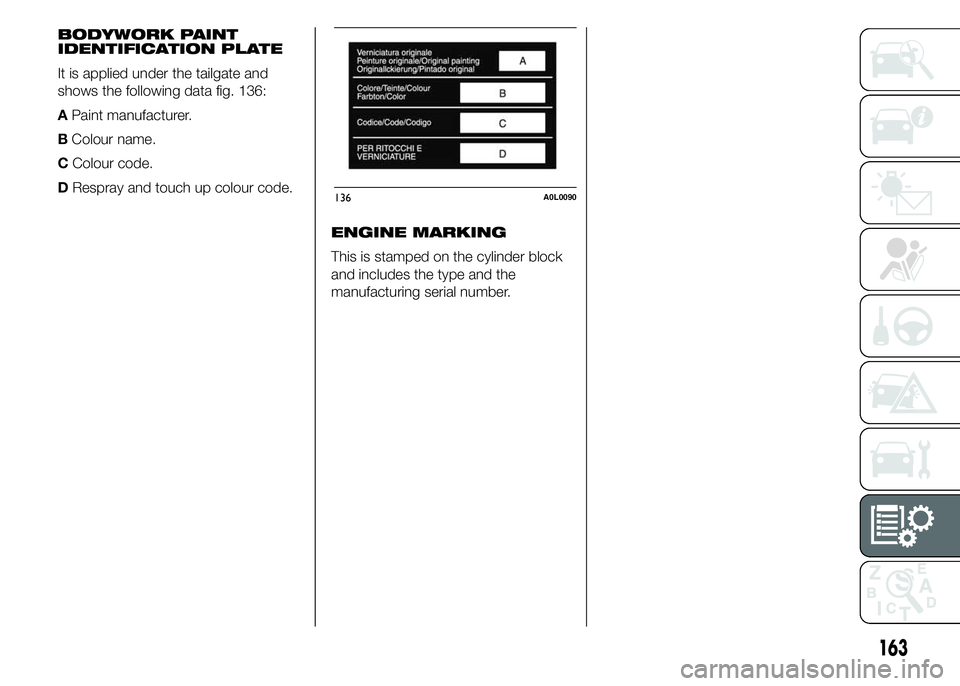
ENGINE MARKING
This is stamped on the cylinder block
and includes the type and the
manufacturing serial number.
136A0L0090
163
BODYWORK PAINT
IDENTIFICATION PLATE
It is applied under the tailgate and
shows the following data fig. 136:
APaint manufacturer.
BColour name.
CColour code.
DRespray and touch up colour code.
Page 168 of 199
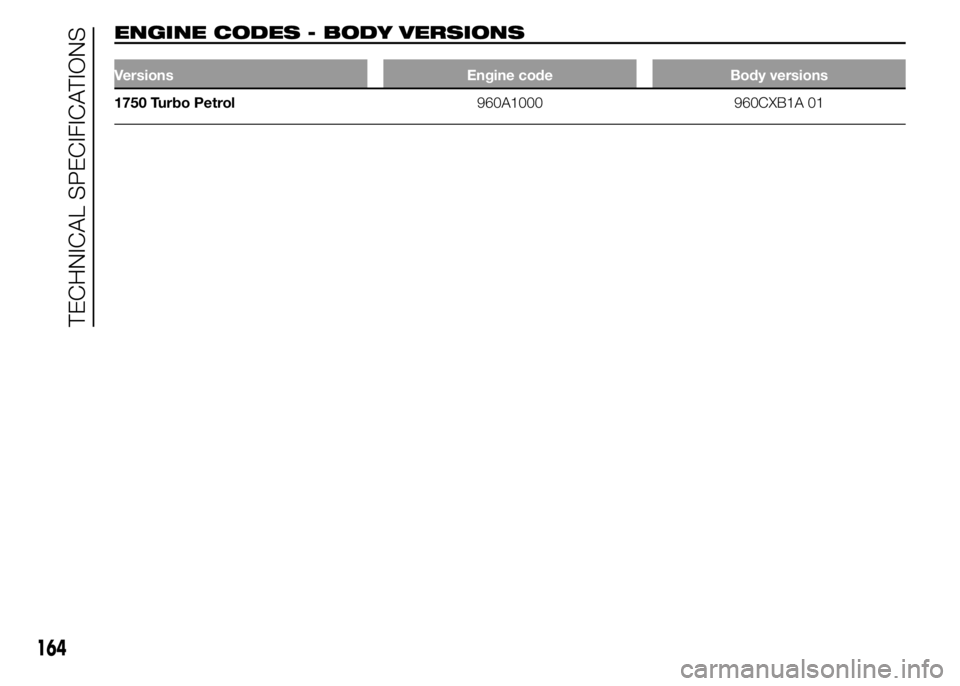
ENGINE CODES - BODY VERSIONS
Versions Engine code Body versions
1750 Turbo Petrol960A1000 960CXB1A 01
164
TECHNICAL SPECIFICATIONS
Page 169 of 199
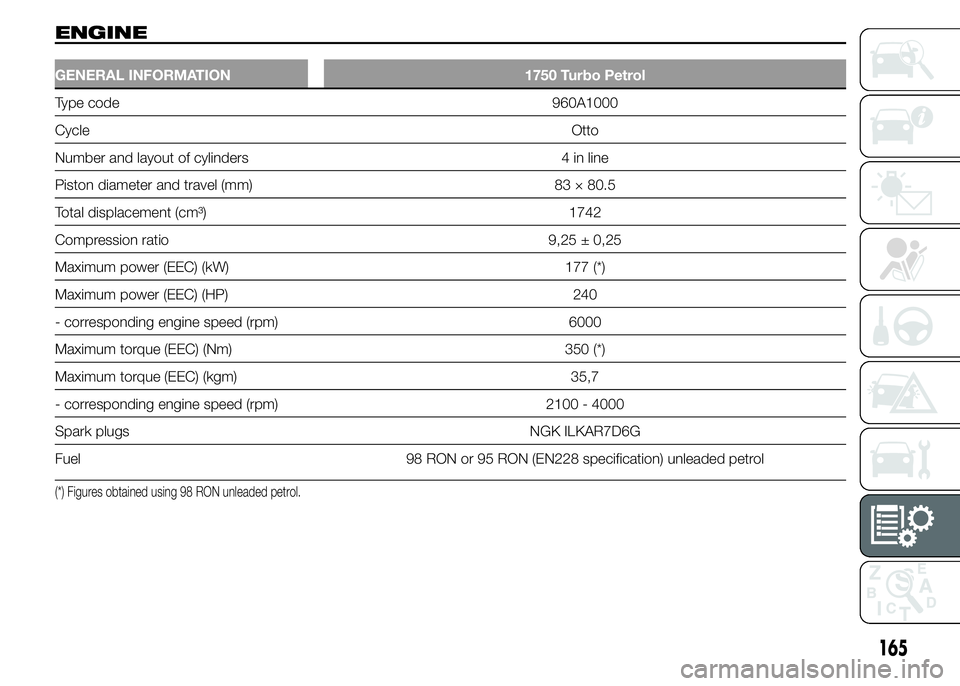
ENGINE
GENERAL INFORMATION 1750 Turbo Petrol
Type code 960A1000
CycleOtto
Number and layout of cylinders 4 in line
Piston diameter and travel (mm) 83 × 80.5
Total displacement (cm³) 1742
Compression ratio 9,25 ± 0,25
Maximum power (EEC) (kW) 177 (*)
Maximum power (EEC) (HP) 240
- corresponding engine speed (rpm) 6000
Maximum torque (EEC) (Nm) 350 (*)
Maximum torque (EEC) (kgm) 35,7
- corresponding engine speed (rpm) 2100 - 4000
Spark plugs NGK ILKAR7D6G
Fuel 98 RON or 95 RON (EN228 specification) unleaded petrol
(*) Figures obtained using 98 RON unleaded petrol.
165
Page 182 of 199
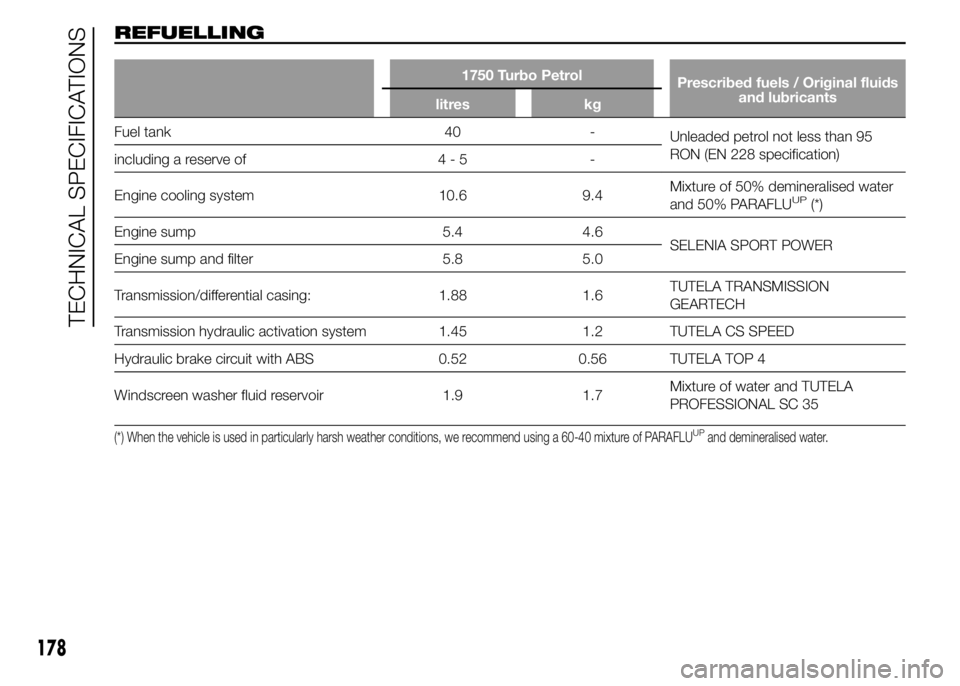
REFUELLING
1750 Turbo Petrol
Prescribed fuels / Original fluids
and lubricants
litres kg
Fuel tank 40 -
Unleaded petrol not less than 95
RON (EN 228 specification)
including a reserve of 4 - 5 -
Engine cooling system 10.6 9.4Mixture of 50% demineralised water
and 50% PARAFLU
UP(*)
Engine sump 5.4 4.6
SELENIA SPORT POWER
Engine sump and filter 5.8 5.0
Transmission/differential casing: 1.88 1.6TUTELA TRANSMISSION
GEARTECH
Transmission hydraulic activation system 1.45 1.2 TUTELA CS SPEED
Hydraulic brake circuit with ABS 0.52 0.56 TUTELA TOP 4
Windscreen washer fluid reservoir 1.9 1.7Mixture of water and TUTELA
PROFESSIONAL SC 35
(*) When the vehicle is used in particularly harsh weather conditions, we recommend using a 60-40 mixture of PARAFLUUPand demineralised water.
178
TECHNICAL SPECIFICATIONS